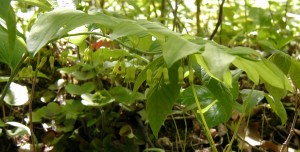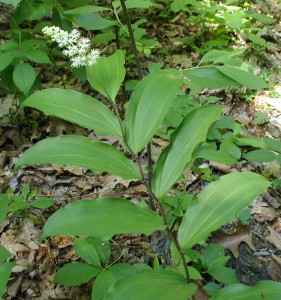The group of Solomon’s Seal plants look similar, especially early in the year when the greenery is just coming up. They all have parallel-veined leaves along a single arching stem and six-pointed flowers.
The plants themselves are different enough to warrant being placed in two different genera. At one time the Solomon’s Seals were all considered members of the Lily Family, Liliaceae. Further research resulted in their classification as members of the Ruscaceae Family, but that is now in question.
Naming and classifying plants is not an easy task as there are several plant taxonomy systems that one might follow. Here at wildeherb we tend to follow the old Cronquist system with its major divisions of Monocots and Dicots, but we do take efforts to highlight accepted newer names for our vegetative friends.
Blossoms tell the story as far as which plants belong to which species. After all flowers are the reproductive parts of the plant. The central idea of a species is that members of a species will be able to reproduce the next generation. Species are isolated from one another by not being able to cross breed or interbreed to produce viable offspring. Hybrid species can be formed, but they do not contribute to the furthering of either parent species.
Comparing flowers, or deciding which plants are of the same species, often comes down to comparison of the floral parts. A case in point is Whorled Pogonia, a native orchid that we were lucky enough to see blooming in 2010 here on the mountain top.
Another example where we need to compare floral parts to for sure distinguish the species from each other are the Solomon’s Seals. The leaves for these related plants could be described as linear, entire, oval shaped leaves having a short tip and arranged alternately along a single arching stem.
Flower placement is axial or terminal in the Solomon’s Seals. Axial flowers hang down from the leaf axils in two Polygonatum species. Terminal flowers grow at the tips of the arching stems in two Maianthemum species.
Smooth Solomon’s Seal, P. biflorum, and Giant Solomon’s Seal, P. canaliculatum, have flowers that dangle from the leaf axils. Smooth Solomon’s Seal has typically two yellow-green bell-shaped flowers per leaf axil. Giant Solomon’s Seal has the same type of flower as Smooth, but they’re usually in a small cluster of 2-10 flowers. Also, the stature of Giant is usually much bigger than Smooth.

Photo above taken 30 April 2010.
False Solomon’s Seal, M. racemosum, and False Starry Solomon’s Seal, M. stellatum, have their blossoms at the tip of the single arching stem. False Solomon’s Seal has a branched cluster of a few dozen small white blossoms. False Starry Solomon’s Seal has fewer, but larger, flowers and they come right off the main stem with no branching.

Photo above taken 31 May 2007.
Fruits are somewhat different among the Solomon’s Seals, but we’ll have to wait a while for them to turn from green into their final colors before making comparisons.
Incidentally, if you’re using an older wild plant guide the Maianthemum species are probably labeled as Smilacina species. False Solomon’s Seal may be listed as S. racemosa and False Starry Solomon’s Seal may be called S. stellata.

2 thoughts on “Solomon’s Seal Smooth Giant False and Starry”